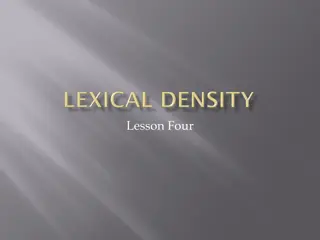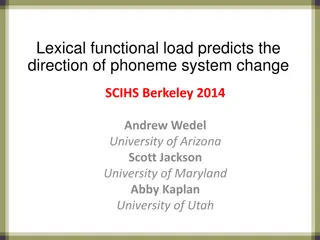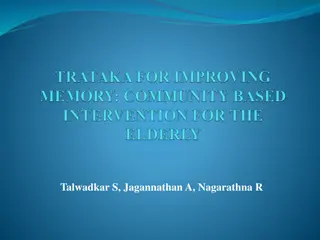Evolution of Lexical Categories: A Cognitive Sociolinguistics Perspective
The lecture series at the University of Leuven explores Diachronic Prototype Semantics and its implications for Variational Linguistics. It delves into semasiological, conceptual onomasiological, and formal onomasiological variation in linguistic meaning, emphasizing the role of variability in the evolution of lexical categories. The content discusses the interconnectedness of prototypicality, polysemy, and synonymy in understanding linguistic structures and the prediction of semantic developments in new concepts.
Download Presentation

Please find below an Image/Link to download the presentation.
The content on the website is provided AS IS for your information and personal use only. It may not be sold, licensed, or shared on other websites without obtaining consent from the author.If you encounter any issues during the download, it is possible that the publisher has removed the file from their server.
You are allowed to download the files provided on this website for personal or commercial use, subject to the condition that they are used lawfully. All files are the property of their respective owners.
The content on the website is provided AS IS for your information and personal use only. It may not be sold, licensed, or shared on other websites without obtaining consent from the author.
E N D
Presentation Transcript
Lecture 3. Diachronic Prototype Semantics University of Leuven RU Quantitative Lexicology and Variational Linguistics
Situating the talk 1-2 3-4 5-6 7-9 10 Introduction Semasiological variation Conceptual onomasiological variation Formal onomasiological variation Conclusion Ten Lectures on Cognitive Sociolinguistics 3
Background D. Geeraerts 1997 Diachronic Prototype Semantics. A Contribution to Historical Lexicology [ Oxford: Oxford University Press ] Ten Lectures on Cognitive Sociolinguistics 3
Question given the fact that variability is so to speak wired-in in contemporary conceptions of linguistic meaning and categorization, can we indeed demonstrate that variability when we look at the evolution of lexical categories? Ten Lectures on Cognitive Sociolinguistics 3
Refreshing your memory semasiological variation: prototypicality and polysemy conceptual onomasiological variation: differences of categorial construal formal onomasiological variation: synonymy Ten Lectures on Cognitive Sociolinguistics 3
TOC Case study I. Semasiological variation in a single meaning (and some onomasiology too) Case study II. Semasiological variation in a polysemic cluster Conclusions Ten Lectures on Cognitive Sociolinguistics 3
Case study I Semasiological variation in a single meaning (and some onomasiology too) Ten Lectures on Cognitive Sociolinguistics 3
Predictions the evolution of a neologism 1. semasiology: if prototypicality is indeed a good model of the semasiological structure of categories, the semantic development of a new concept will take the form of growing variations and modulations of the initial prototypical core Ten Lectures on Cognitive Sociolinguistics 3
Predictions 2. conceptual onomasiology: if a new concept is succesful, this will become apparent in the growing entrenchment (onomasiological salience of that concept) 3. formal onomasiology: competition between sociolinguistically marked alternatives Ten Lectures on Cognitive Sociolinguistics 3
Case study: legging evolution from 1988 to 1992 corpus of magazines, representative for the distinction between Netherlandic Dutch and Belgian Dutch referential description in componential format (six dimensions) e.g. <31111f> Ten Lectures on Cognitive Sociolinguistics 3
Case study: legging evolution from 1988 to 1992 corpus of magazines, representative for the distinction between Netherlandic Dutch and Belgian Dutch referential description in componential format (six dimensions) e.g. <31111f> Ten Lectures on Cognitive Sociolinguistics 3
The componential system L length 3 / 2 as long as the calves or ankles W width 1 tight-fitting C crease 1 no crease M material 1 finely woven, elastic material F function 1 worn as an upper garment S sex f worn by a woman Ten Lectures on Cognitive Sociolinguistics 3
The representation - representation of the semasiological range of the category legging as a cluster of overlapping subsets - following the evolution during five years gradual expansion of the prototypical core: from minimal to maximal deviance from the prototype Ten Lectures on Cognitive Sociolinguistics 3
L =2,3 M=1 W=1 S=f 14 1 3 F=1 Ten Lectures on Cognitive Sociolinguistics 3
L =2,3 M=1 W=1 3 S=f 14 1 F=1 Ten Lectures on Cognitive Sociolinguistics 3
L =2,3 M=1 W=1 3 S=f 23 3 4 13 3 F=1 Ten Lectures on Cognitive Sociolinguistics 3
L =2,3 M=1 1 W=1 7 S=f 116 26 33 4 F=1 3 2 1 Ten Lectures on Cognitive Sociolinguistics 3
L =2,3 M=1 W=1 1 18 4 S=f 174 28 1 1 69 12 F=1 1 5 2 Ten Lectures on Cognitive Sociolinguistics 3
To recapitulate legging is a tight-fitting, elastic, long kind of trousers for women but the word is used loosely: sometimes leggings are less tight-fitting, sometimes a bit shorter etc. the way in which the word is used loosely is characterized by two features: UCM 10 March 2009
To recapitulate 1. the novel applications take the form of co-variation along different dimensions, many of them continuous rather than binary ones 2. considered in time, the novel applications take the form of a gradual expansion of the prototypical core cases UCM 10 March 2009
Conceptual onomasiology extrapolating the semasiological notion of salience (= prototypicality) to the onomasiological domain: a cognitive preference for choosing one category rather than another as the name for a given referent or set of referents an operational definition of onomasiological entrenchment in a given corpus: Ten Lectures on Cognitive Sociolinguistics 3
Defining entrenchment frequency of category name(s) frequency of category referents Ten Lectures on Cognitive Sociolinguistics 3
Applying entrenchment applying the operational definition: overall frequency of legging-leggings-cale on overall frequency of all referents of legging-leggings- cale on, even where not named by those items Ten Lectures on Cognitive Sociolinguistics 3
Growing entrenchment 1988 1989 1990 1991 1992 frequency of names 18 21 47 185 318 frequency of referents 52 57 83 231 404 entrenchment 0.34 0.36 0.56 0.80 0.78 Ten Lectures on Cognitive Sociolinguistics 3
Formal onomasiology choices between denotational synonyms, revealing the relationship between language varieties in this case: reflecting the normative relations between Netherlandic Dutch and Belgian Dutch (Flemish) Ten Lectures on Cognitive Sociolinguistics 3
A converging shift B NL cale on legging(s) cale on legging(s) 1988 100% - - - 1989 100% - - 100% 1990 96.9% 3.1% - 100% 1991 55.5% 44.5% 0.9% 99.1% 1992 66.5% 33.5% - 100% Ten Lectures on Cognitive Sociolinguistics 3
A converging shift more internal variation in B than in NL more influence from French in B than in NL B seems to converge normatively with NL (historical interpretative background) Ten Lectures on Cognitive Sociolinguistics 3
Case study II Semasiological variation in a polysemic cluster Ten Lectures on Cognitive Sociolinguistics 3
An example Dutch tuimelen, to tumble classified into 9 senses with material for 4 centuries (16-19) to be presented: definition / semantic gloss an example timeline Ten Lectures on Cognitive Sociolinguistics 3
Introducing Tuimelen to make somersaults, go head over heels 16a 19b (Uilenspiegel) was seer auontuerlijck als hi inder wieghen lach, want hi tumelde tumelde op dat cussen ende bedde ende stack den eers om hooge [1520]. Uilenspiegel was very adventurous when he was a baby lying in the cradle, because he tumbled pillow and the blanket, and put his behind in the air. tumbled on the Ten Lectures on Cognitive Sociolinguistics 3
Introducing Tuimelen to make somersaults, go head over heels 16a 19b (Uilenspiegel) was seer auontuerlijck als hi inder wieghen lach, want hi tumelde tumelde op dat cussen ende bedde ende stack den eers om hooge [1520]. Uilenspiegel was very adventurous when he was a baby lying in the cradle, because he tumbled pillow and the blanket, and put his behind in the air. tumbled on the Ten Lectures on Cognitive Sociolinguistics 3
Introducing Tuimelen to fall down 16b 19b Zoo zaen als zij eenich gheruchte hoorden, meenden terstont dat die van Ghendt uut quamen om haer doot te smijten, waeromme zij somtijts liepen ende tumelden tumelden over hoop, vielen in grachten als verbaesde meinschen [1566] As soon as the besiegers heard a noise, they immediately thought that the inhabitants of Ghent rushed out to smite them. That is why they sometimes ran away, tumbled tumbled one over the other, fell into ditches like flabbergasted people do Ten Lectures on Cognitive Sociolinguistics 3
Introducing Tuimelen to whirl down, fall with a whirling movement 18a 19b Dees (een matroos) uit onvoozichtigheit zyne hant houdende voor den mont van een stuk geschut, wert zoo jammerlyk gequetst, dat hy los van boven ne r naer beneden tuimelde tuimelde [1714] This sailor, holding his hand imprudently before the mouth of a canon, got wounded so severely that he tumbled tumbled down from the ship. Ten Lectures on Cognitive Sociolinguistics 3
Introducing Tuimelen to whirl (freely, without falling) 18a 19b Wel aan, zo 't u lust, wy zingen eens by beurt, Dat zelf de Maasgodt worde in 't stroompaleis gesteurt, En opwelt met zyn stoet op tuimlende Well then, if you like, we will sing taking turns, so that even the local river god in his streaming palace will be disturbed, and will rise from the waves with his courtiers on tumbling tumbling dolphins tuimlende dolfynen [1710] Ten Lectures on Cognitive Sociolinguistics 3
Introducing Tuimelen to whirl, move in an agitated way (figuratively) 18b Aldus woelen, tuimelen tuimelen, en barnen (= branden) hier verscheiden hartstoghten [1759] And so various passions toss, tumble tumble and burn Ten Lectures on Cognitive Sociolinguistics 3
Introducing Tuimelen to fall down (figuratively) 19a 19b Ware B. met de kous op den kop 't huis gekomen, het Ministerie zoude getuimeld getuimeld zijn, maar de Koning had de Regering behouden [1830] Had B. come home without results, the Government would have tumbled tumbled, but in actual fact the king succeeded in keeping his Government. Ten Lectures on Cognitive Sociolinguistics 3
Introducing Tuimelen to pivot, turn round one s axis 19a 19b Het gebruik van gegoten ijzeren ramen is in de laatste tijd aanmerkelijk toegenomen, ...; gewoonlijk worden zij als vaste ramen aangewend, waarin zich een draaijend of tuimelend tuimelend gedeelte bevindt [1848] The use of cast-iron windows frames has increased greatly in recent times, .... Usually they are used as fixed windows with a part that swings or tumbles open tumbles Ten Lectures on Cognitive Sociolinguistics 3
Introducing Tuimelen to sway, stagger, almost fall down 19b Hikkende, brakende, tuimelend achteren, zijn evenwicht herstellend met de voorpooten, waggelde hij (een stier) voort [1889] Hiccupping, vomitting, tumbling tumbling over its hind legs, re- establishing its balance on its front legs, the bull staggers on. tuimelend over zijn pooten van Ten Lectures on Cognitive Sociolinguistics 3
Introducing Tuimelen to wind up in, involuntarily reach a certain position (figuratively) 19b Steeds we r ben ik in mijne schrijverijen van 't eene onderwerp in 't andere getuimeld getuimeld, zonder richtsnoer, zonder vooraf berekend plan [1885] Ever again I have tumbled tumbled from one subject into the other in my writings, without guiding line, without preconceived plan. Ten Lectures on Cognitive Sociolinguistics 3
Overview Tuimelen semantic extensions based on literal similarity (fall down, whirl down, whirl freely, pivot) metaphorical similarity (fall down figuratively, whirl figuratively, wind up figuratively) metonymy (sway) Ten Lectures on Cognitive Sociolinguistics 3
Overview Tuimelen roll round one s axis + + - - + + + + + + touching the ground + + + + - - - - - - in downward movement + + + + + + - - - - with purpose and intention + + - - - - + + - - somersaults fall down whirl down whirl freely pivot Ten Lectures on Cognitive Sociolinguistics 3
Representing change three ways of representing semasiological change chronological steps in radial sets a hybrid family resemblance approach a global linear approach (advantages and disadvantages) Ten Lectures on Cognitive Sociolinguistics 3
Tuimelen in steps Ten Lectures on Cognitive Sociolinguistics 3
Tuimelen in steps Ten Lectures on Cognitive Sociolinguistics 3
Tuimelen in steps Ten Lectures on Cognitive Sociolinguistics 3
Tuimelen in steps Ten Lectures on Cognitive Sociolinguistics 3
Tuimelen in steps Ten Lectures on Cognitive Sociolinguistics 3
Tuimelen in steps Ten Lectures on Cognitive Sociolinguistics 3
Tuimelen in steps Ten Lectures on Cognitive Sociolinguistics 3
Tuimelen 16a Ten Lectures on Cognitive Sociolinguistics 3























